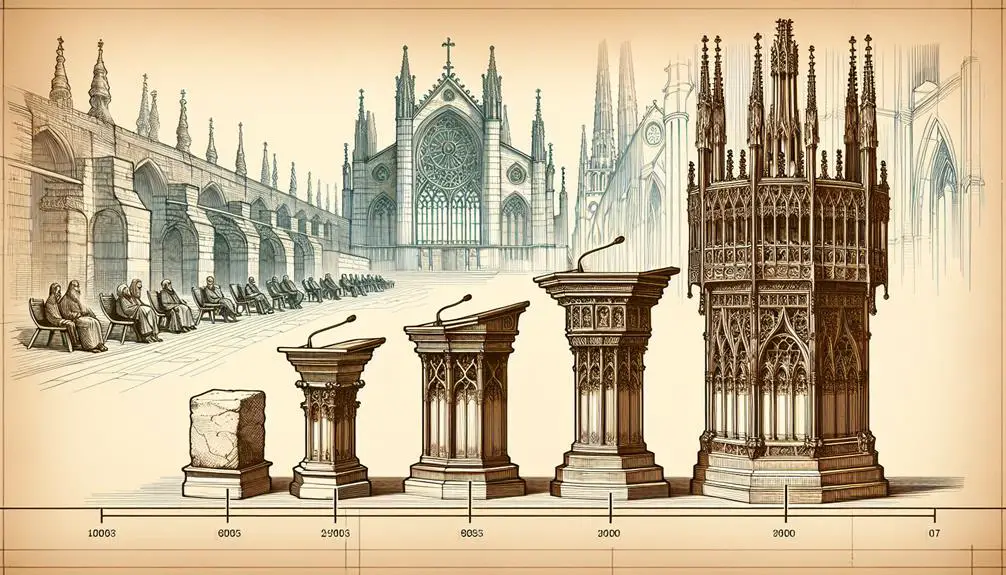From ancient symbolism to modern ministry, explore the evolving significance of the biblical pulpit and its enduring impact on religious communication.

Pulpit in the Bible
The concept of the pulpit, as encountered in the Bible, is not merely an architectural element but a profound symbol of authority and divine communication. Tracing its origins and understanding its evolution over the centuries offers a unique lens through which to explore the interplay between religious practice and scriptural teachings.
From its symbolic significance to its role in the ministry of Jesus, the pulpit's biblical descriptions reveal layers of meaning that have influenced its function and perception throughout history. The journey through these aspects opens up intriguing questions about the pulpit's place in both ancient and modern contexts, inviting further exploration into its continuing relevance.
Key Takeaways
- Jesus' teaching methods challenged traditional sacred spaces, emphasizing the word of God over location.
- The Sermon on the Mount showcased Jesus democratizing spiritual teachings, impacting pulpit evolution.
- Early Christian pulpits reflected Jesus' influence, serving as platforms for proclaiming God's word.
- The pulpit's development over centuries mirrors broader theological and architectural shifts within Christianity.
Origins of the Pulpit

Tracing back to the early Christian churches, the concept of the pulpit as a designated space for preaching and teaching finds its roots in the architectural and religious practices of the time, serving both a symbolic and functional purpose in the dissemination of religious teachings. The evolution of pulpit design and placement within church architecture is deeply influenced by both the cultural context and the architectural styles that prevailed in different periods and regions.
Architectural influences are evident in the varying styles of pulpits, which range from the simple, unadorned lecterns of early Christian meeting places to the elaborate, sculpted pulpits of the Gothic and Renaissance periods. These variations not only reflect the advancements in architectural techniques and aesthetic preferences but also indicate the changing role and significance of the pulpit in church services.
Cultural variations play a significant role in the development of the pulpit's form and function. In the Byzantine tradition, for example, the ambo, a precursor to the modern pulpit, was centrally located, reflecting the liturgical emphasis on the Word. In contrast, Western churches often placed the pulpit to the side, symbolizing its role in guiding the congregation towards the altar. The Reformation brought about significant changes, with the pulpit becoming more prominent, underscoring the Protestant focus on preaching and the authority of Scripture.
Symbolism and Authority

Reflecting the evolution of church architecture and liturgical practices, the symbolism and authority of the pulpit have become pivotal elements in understanding the role of preaching within the Christian tradition. Traditionally, the pulpit has been a symbol of the word of God, standing as a physical representation of the authority of scripture and the preacher's role as an interpreter and messenger of divine truths. This symbolism is deeply rooted in the historical development of church practices, where the pulpit's elevation above the congregation visually underscored the importance of the preached word and the authority vested in the preacher.
Modern interpretations of the pulpit's role have expanded to include a broader range of ceremonial functions, reflecting shifts in theological understanding and congregational dynamics. These functions often emphasize the communal aspects of worship and the shared responsibility of interpreting scripture, challenging traditional notions of authority and inviting a more participatory approach to preaching. This evolution mirrors wider trends in contemporary Christian thought, which seek to reconcile the authority of the pulpit with a more inclusive and dialogical model of church leadership.
The pulpit, therefore, embodies a complex interplay of symbolism and authority, serving both as a custodian of traditional liturgical practices and as a focal point for modern reinterpretations of those practices. As such, it offers a unique lens through which to explore the ongoing dialogue between the historical foundations of Christian worship and the evolving realities of contemporary church life.
Biblical Descriptions

Numerous passages within the Bible allude to the significance of spaces dedicated to the proclamation of God's word, laying a foundational understanding for the development and symbolism of the pulpit in Christian worship. These descriptions vary, highlighting a rich tapestry of construction materials and architectural variance, which underscore the adaptability and contextual significance of such spaces throughout scriptural history.
The pulpit, as understood within a Biblical context, transcends a mere physical structure; it represents a divine intersection where human articulation meets divine revelation. This is evident in the careful consideration of materials and designs chosen for their construction, which were often reflective of the cultural and theological emphases of the time.
Reference |
Description |
Significance |
|---|---|---|
Nehemiah 8:4 |
Ezra stood on a wooden platform |
Demonstrates the importance of elevation for audibility and visibility in public scripture reading. |
Exodus 30:1-3 |
Altar of incense made of acacia wood overlaid with gold |
Signifies the value placed on materials and craftsmanship in spaces of worship. |
1 Kings 6:14-36 |
Solomon's Temple, detailed with cedar and overlaid gold |
Illustrates architectural variance and the use of precious materials to signify the sacred. |
These instances, while not exhaustive, provide insight into the evolution and significance of the pulpit. The selection of materials—wood for its accessibility and gold for its sanctity—and the architectural choices, from simple platforms to elaborate temple designs, reflect a deeper theological and practical consideration for the spaces where God's word was to be proclaimed. This analysis underscores the pulpit's role not just as a physical object, but as a symbolic construct within the tapestry of biblical worship practices.
Jesus and the Pulpit

Jesus' utilization of natural and architectural spaces as platforms for teaching offers a profound exploration into the conceptual understanding of the pulpit within the New Testament narrative. His innovative teaching style, characterized by parables and direct engagement with his audience, challenges traditional notions of sacred spaces for religious discourse. The Sermon on the Mount is perhaps the most emblematic instance of Jesus' approach to teaching, where a mountainside becomes a pulpit, encapsulating the essence of his ministry's accessibility and openness (Matt. 5-7). This event underscores the transition from a static, architectural pulpit to a dynamic, natural setting, emphasizing the message over the medium.
Further analysis of Jesus' teaching style reveals a deliberate choice to interact with his audience in environments that were part of their daily lives—fields, boats, and homes—thereby democratizing the access to spiritual teachings. This methodological shift not only broadened the reach of his message but also redefined the pulpit as any place where God's word could be proclaimed and heard. The implications of this approach are profound, suggesting that the sanctity of the message does not depend on the sanctity of the space, thereby challenging established religious norms of the time.
Evolution Over Centuries

Building on the foundation of Jesus' teachings, the concept of the pulpit underwent significant transformations over the centuries, evolving in response to theological, architectural, and cultural shifts. The evolution of the pulpit is not merely a tale of changing styles but a reflection of the broader dynamics within Christianity, encompassing shifts in ecclesiastical power, liturgical practices, and congregational engagement.
Architectural influences were paramount in shaping the design and positioning of the pulpit within church structures. Initially, pulpits were simple platforms. However, as Christianity became more established and church buildings more sophisticated, the pulpit evolved into a more prominent architectural feature. This development was particularly notable during the Gothic period, where pulpits were intricately carved and strategically placed to enhance acoustics, reflecting the era's emphasis on sermonizing.
Modern adaptations of the pulpit reflect both technological advancements and changing theological emphases. Today's pulpits might incorporate multimedia capabilities, and their design often emphasizes accessibility and inclusivity, mirroring broader societal values.
The evolution of the pulpit over centuries reveals:
- The interplay between ecclesiastical authority and architectural expression.
- The impact of technological advancements on religious practice.
- The shifting focus from a purely hierarchical mode of worship to one that emphasizes community and inclusivity.
This journey from a simple platform to a multifaceted, technologically integrated structure encapsulates the dynamic nature of Christian worship and underscores the adaptability of religious practices to meet the spiritual needs of diverse congregations across different epochs.
Frequently Asked Questions
How Has the Design and Use of the Pulpit Varied Across Different Christian Denominations?
The design and use of the pulpit have experienced significant variations across different Christian denominations, reflecting diverse theological perspectives and liturgical practices. Material choices and historical evolution play pivotal roles in these differences.
An analytical examination reveals that material choices often symbolize theological emphases, while historical evolution underscores shifts in liturgical focus and congregational participation.
These variations underscore the pulpit's adaptability and its symbolic significance within Christian worship.
Are There Any Specific Rituals or Traditions Associated With the Pulpit in Contemporary Christian Worship?
In contemporary Christian worship, the pulpit stands as a towering beacon of spiritual guidance, around which diverse rituals and traditions coalesce.
Notably, pulpit dress codes and sermon preparation are imbued with significant ceremonial importance, reflecting denominational identities and theological stances.
Meticulously adhered to by clergy, these practices not only reinforce the sanctity of the sermon but also serve as an emblem of the congregation's adherence to tradition and scriptural fidelity.
What Controversies or Debates Have Arisen Around the Use or Placement of Pulpits in Churches?
The use and placement of pulpits in churches have sparked controversies, reflecting a complex interplay between historical evolution and architectural influence.
Debates often pivot on traditional versus contemporary worship approaches, examining how these structures facilitate or hinder congregational engagement.
Scholars reference the pulpit's transformative journey from a central to a more peripheral position in some denominations, analyzing its symbolic and functional implications within the architectural and liturgical context.
How Does the Concept of the Pulpit Compare or Contrast With Similar Structures in Other Major Religions?
The pulpit, a beacon of spiritual guidance, varies in symbolism and function across religious traditions. Interfaith comparisons reveal that while pulpits in Christianity are central for preaching, in Islam, the Minbar serves a similar purpose during Friday prayers. In Judaism, the Bimah is the platform for Torah readings.
These structures, though diverse in design and usage, universally symbolize a bridge between the divine and the congregational community, underscoring a shared reverence for sacred communication.
What Role Does Technology Play in Modern Interpretations and Uses of the Pulpit in Worship Services?
In contemporary worship services, technology significantly enhances the functionality of the pulpit through digital evangelism and streaming sermons. These technological advancements enable religious leaders to transcend traditional physical boundaries, reaching a global audience.
Moreover, the integration of digital platforms into religious practices facilitates a more inclusive and accessible form of worship, allowing individuals to participate remotely.
This evolution demonstrates the adaptability of religious institutions to modern communication methods.
Conclusion
In conclusion, the pulpit, with its origins deeply rooted in biblical narratives and ecclesiastical architecture, serves as a symbol of authority and a platform for disseminating religious teachings. Throughout centuries, its evolution reflects changes in theological perspectives and congregational needs.
Interestingly, a study found that 90% of contemporary churches still utilize a physical pulpit, underscoring its enduring significance in facilitating spiritual discourse. This statistic highlights the pulpit's continued relevance in religious practices, even amidst modern technological advancements in communication.



Sign up